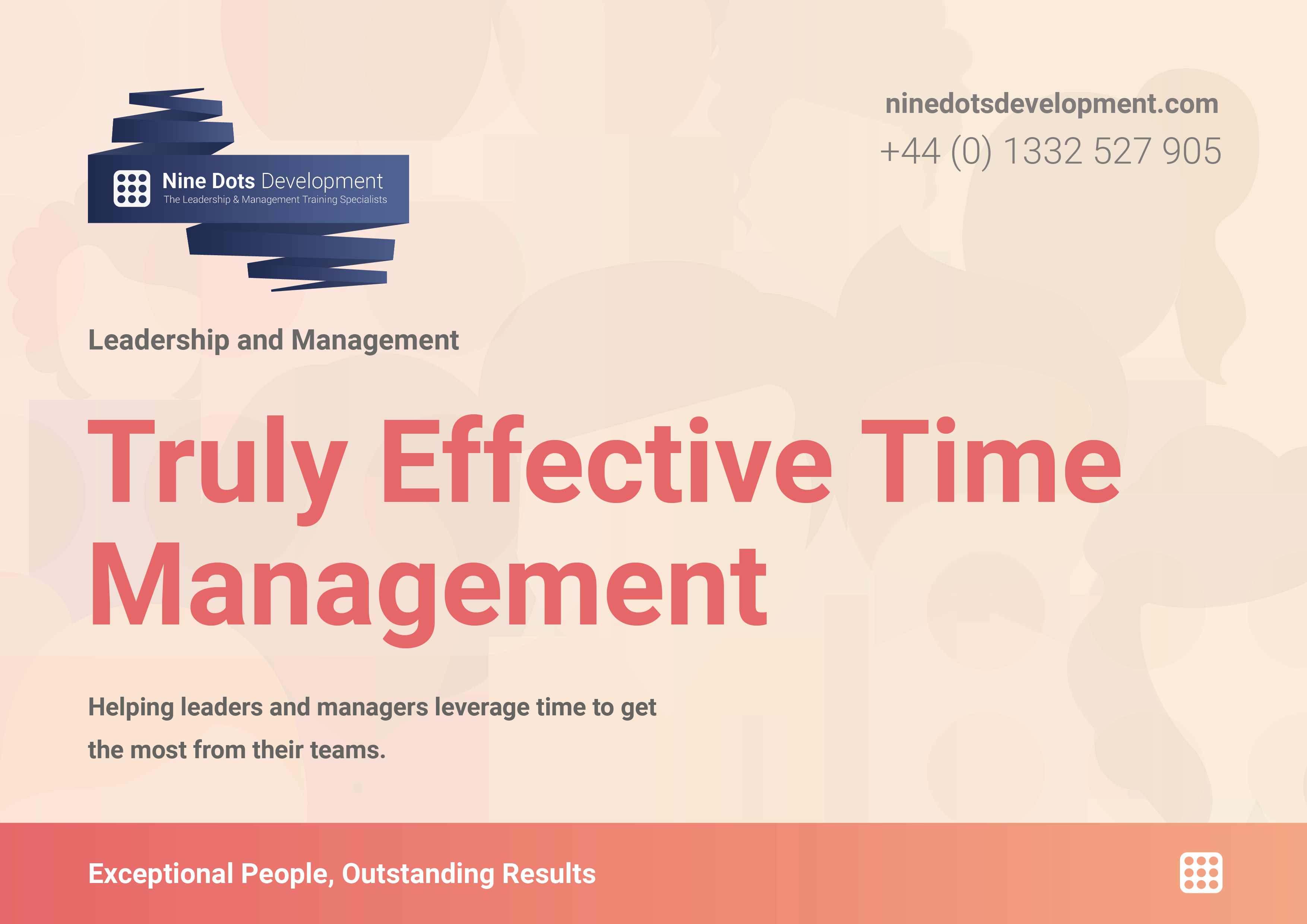Wednesday 22 Sep 2021 Article
The Takeaway9 Ways Leaders and Managers Can Leverage Employees’ Time
Struggling with Time Management?
Part 3
#PrivateTraining #Leadership #Management #Time #Leverage #Workload #TrulyEffectiveTimeManagement #PersonalDevelopment
The perfectly matched resource for this article...
Our 'Truly Effective Time Management' Programme
If any of your managers or leaders struggle with managing and getting the most out of their own or their team’s time, our ‘Truly Effective Time Management’ programme would be perfect for them.
Download brochure!Playing catchup?
9 Ways Leaders and Managers Can Leverage Employees’ Time
Getting the most from a business is all about leverage. Typically, a business can be leveraged in 3 ways:
- Money
Investing money in various ways so that it gains interest over time - Technology
Doing work once which can be brought repeatedly with a zero margin cost - Time
Making the most of others’ and own time
While leaders and managers usually don’t have much control over money and technology in their company, they are responsible for making the most of staff’s time.
In today’s article, we explore 9 ways leaders and managers can leverage their employees’ time.
1. Balance Employees’ Workloads
There’s no good in having one staff member run off their feet with work whilst another is sitting around trying to think of something to do. Balancing employees’ workloads through effective delegation helps ensure that everyone’s time is being leveraged and that everything gets done on time. Making sure that employees aren’t being overworked is also crucial to looking after their wellbeing and making sure they don’t burn out, costing more time in the long run.
2. Work Staff to Their Strengths
Another aspect of effective delegation is being able to work staff to their strengths by assigning the right tasks to the right people. This starts with actually knowing what staff’s strengths are. Leaders can identify their employees’ strengths and skills in many different ways, including:
- 1-1 performance reviews where employees are asked what they perceive their own strengths to be
- Observing employees to see how they work on a day-to-day basis
- Collecting feedback from employees’ colleagues - it’s important to get this feedback from somebody unbiased
3. Use Systems to Make Tasks Clear and Information Readily Available
Keeping track of projects and progress being made means leaders can identify the next tasks that need to be completed by their staff, and when they need to be completed by. Using a clear system to display this information is crucial to making sure employees fully understand what they should be doing. In one of our previous articles, we explored how using Todoist has transformed the way we operate and supercharged our achievements.
{{ADVERT}}
4. Identify Where Employees Can Double-up On Tasks
Leveraging time is all about getting the most out of the limited time we have available and identifying where employees can double-up on tasks helps them achieve more in the same amount of time. For example:
- Merging multiple meetings into one and shortening them
- Walking and talking
- Discussing ideas over lunch
5. Create Policies and Procedures to Keep Staff Focused
One of the biggest culprits of wasted time is staff getting distracted by things like mobile phones and general office chit-chat. Having policies in place, like mobile phones having to be kept on silent, helps reduce distractions and keep employees work-focused. Implementing practices like Pareto’s 80:20 Law and the Pomodoro Method also help employees concentrate and get more out of their time by making sure they are doing the right tasks, at the right time, and in the right way.
6. Establish Clear Communication Channels
Establishing clear communication channels and expectations helps reduce the time needed for communication and increases efficiency. For example, encouraging staff to cut out unnecessary ‘fluff’ from their emails means that they are quicker to write, but also quicker to read and action by the recipient. Encouraging frequent, effective communication also helps prevent staff from working in silos where important information may not be communicated, potentially leading to issues later on that take valuable time to solve. Here are Nine Dots, we use Slack as our primary communication channel and have found that keeping communication simple and in one place has allowed us to communicate and collaborate much more effectively and efficiently.

7. Recognise Employees’ Achievements
As we discussed in our previous ‘Remember to Recognise and Celebrate Employee Success’ article, recognising employees’ achievements can not only motivate the individual, but also serve as a learning point for other employees by showing them what they should be doing. For example, praising a member of staff for correctly prioritising the tasks on their to-do list encourages other employees to do the same and re-evaluate how they are working. Motivating employees through recognition can really boost their morale and job satisfaction, making them much more likely to want to work hard and strive to achieve and exceed goals.
8. Keep Track of Tasks Through Key Results
In his book ‘Measure What Matters’, John Doerr explains that everything that matters to an organisation or team should be measured and kept track of. Employees should also have full visibility of what metrics they are measured on so that they know what they’re working towards. A great way to keep track of tasks is by using OKRs, the goal-setting methodology that took Google to new heights, which we covered in another previous article here.
9. Put Up Roadblocks to Stop Time Takers
Employees only have a limited amount of time and therefore it’s crucial to protect it and spend it wisely. However, this is often easier said than done as other staff members are often the biggest time takers, making requests that distract employees from the task at hand and use up their valuable time. Leaders are ultimately responsible for stopping these time takers, and can do this by:
- Encouraging employees to have Do Not Disturb (DND) time
- Implementing a policy that states that all requests must come through leaders/managers first
- Reducing unnecessary meetings/making sure that staff only attend meetings that they actually need to be in

Want to Take Your Organisation’s Time Management Skills to the Next Level?
Encouraging your managers and leaders to follow the 9 tips above is a fantastic starting point for managing employees’ time better, but there is a lot more to truly leveraging time.
If any of your managers or leaders struggle with managing and getting the most out of their own or their team’s time, have you considered supporting them through professional time management training?
Our ‘Truly Effective Time Management’ programme covers all of the fundamentals of leveraging time, including:
- Understanding what motivates individuals
- Confident motivation and delegation
- Monitoring and reviewing performance
- Creating and maintaining high performance teams
- Effective project management
You can download our course brochure by clicking here, or request a call with one of our training experts here.
---
Until next time...
Our 'Truly Effective Time Management' Programme
If any of your managers or leaders struggle with managing and getting the most out of their own or their team’s time, our ‘Truly Effective Time Management’ programme would be perfect for them.
Download brochure!Missed an article?
More from Struggling with Time Management?
